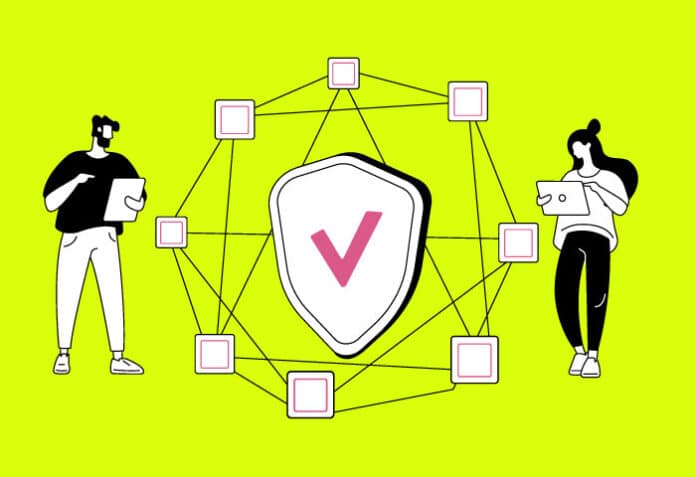Characterised by enhanced security, transparency, and efficiency, DApps are paving the way for a future where individuals have greater control over their data and interactions. In short, they are changing the way we interact with technology.
Decentralised applications (DApps) are reshaping the way we interact with technology. Unlike traditional applications that rely on central authorities, DApps utilise blockchain technology to create a trustless and transparent environment for users. With the rise of cryptocurrencies and blockchain platforms like Ethereum, the potential for DApps to disrupt various industries is becoming increasingly evident.
What exactly are DApps?
DApps are decentralised applications that operate on a peer-to-peer network of computers, utilising blockchain technology. Unlike traditional applications that are controlled by a central authority, DApps function independently, without any central governing entity. This decentralised nature ensures transparency, security, and immutability, making DApps highly resilient to censorship or malicious activities.
DApps are typically open source, allowing developers to contribute and modify the source code while adhering to predetermined consensus rules. They also employ smart contracts for the execution of predefined protocols, further enhancing their efficiency and trustworthiness. These characteristics differentiate DApps from their centralised counterparts, offering users greater control over their data and enhancing overall security.
The basics of decentralised applications
To understand decentralised applications, we must first grasp the concept of blockchain technology. Traditionally, applications rely on central servers to store and process data, leading to concerns about privacy, security, and single points of failure. Unlike centralised applications, decentralised applications operate on distributed networks that are not controlled by a single entity.
At the heart of DApps lies the blockchain, a distributed ledger that records transactions and interactions between participants. Smart contracts, which are self-executing agreements with predefined rules, automate processes and eliminate the need for intermediaries. This decentralised infrastructure ensures trust, transparency, and security.
Real-world DApp use cases
DApps are finding numerous applications across various industries. Here are some prominent real-world use cases of DApps.
Finance
Decentralised finance (DeFi) applications are gaining significant traction, offering users transparent and inclusive financial services. DApps like Compound, Aave, and Uniswap enable lending, borrowing, and decentralised trading without relying on traditional intermediaries.
Supply chain management
DApps provide an immutable and transparent record of supply chain activities. This enables businesses to track and verify the origin, authenticity, and movement of goods. Projects like VeChain and Origin Trail aim to optimise supply chain processes by leveraging the power of blockchain technology.
Gaming
DApps are disrupting the gaming industry by introducing ownership and interoperability of in-game assets. Games like Axie Infinity and Cryptokitties allow players to own, trade, and monetise virtual assets securely on the blockchain, creating a new paradigm for the gaming experience.
Governance
DApps are empowering decentralised governance models by providing transparent decision-making processes. Projects like Aragon and DAOstack enable token holders to participate in voting, proposal creation, and governance activities, allowing for decentralised and inclusive decision-making.
Advantages of decentralised applications
DApps offer a range of advantages.
Transparency and security
One of the key advantages of DApps is their transparency. Since all transactions are recorded on the blockchain, anyone can verify the integrity of the data. This transparency reduces the risk of fraud and promotes accountability. Moreover, the decentralised nature of DApps makes them resistant to hacking attempts. Unlike centralised databases, which are vulnerable to cyberattacks, the distributed nature of the blockchain adds an extra layer of security.
Elimination of intermediaries
In traditional applications, intermediaries such as banks, payment processors, or centralised exchanges facilitate transactions. These intermediaries often impose additional costs and delays. With DApps, intermediaries are largely eliminated. Smart contracts enable direct peer-to-peer transactions, cutting out unnecessary middlemen. This not only reduces costs but also accelerates the speed of transactions.
User control and ownership
With DApps, users gain greater control over their data and digital assets. Traditional applications often collect and monetise user data without consent. In contrast, DApps allow users to retain ownership of their data and determine how it is used. This shift in control empowers individuals and protects their privacy.
Global accessibility
Decentralised applications have the potential to bridge the global digital divide. Since they operate on the internet, DApps can be accessed by anyone with an internet connection. This opens opportunities for individuals in underserved regions to participate in the digital economy, access financial services, and engage in online transactions.
Challenges and limitations of decentralised applications
While decentralised applications offer numerous advantages, they also face certain challenges and limitations that must be addressed for widespread adoption.
Scalability
One of the primary challenges faced by DApps is scalability. Blockchain networks, especially those utilising proof-of-work consensus algorithms, have limited processing capacity. This results in slower transaction times and higher fees during periods of high demand. To overcome this challenge, various scaling solutions such as Layer 2 protocols, and improved consensus mechanisms are being developed.
User experience
The user experience in decentralised applications is often criticised for being complex and unintuitive. Interacting with DApps typically requires users to manage their private keys and understand the intricacies of blockchain technology. Improvements in user-friendly interfaces and streamlined processes are necessary to enhance the adoption of DApps among mainstream users.
Regulatory and legal frameworks
As decentralised applications gain popularity, regulatory and legal frameworks are evolving to accommodate this new technological landscape. The decentralised nature of DApps poses challenges for authorities in terms of jurisdiction, compliance, and enforcement. Striking the right balance between innovation and regulation is crucial to ensure the long-term success of decentralised applications.
Energy consumption
Certain blockchain networks, particularly those utilising proof-of-work consensus algorithms, consume significant amounts of energy. This energy consumption has raised concerns about the environmental sustainability of DApps. The development of more energy-efficient consensus algorithms, like proof-of-stake, is a step towards addressing this challenge.
The future of decentralised applications
As the potential of decentralised applications continues to be realised, their impact on various industries is expected to grow significantly. Here are some areas where DApps are making waves.
Finance
Decentralised finance, often referred to as DeFi, is one of the most prominent use cases for DApps. DeFi applications enable users to access financial services such as lending, borrowing, and trading without intermediaries. These applications provide greater financial inclusivity, lower costs, and increased transparency.
Supply chain management
Decentralised applications have the potential to revolutionise supply chain management. By leveraging blockchain technology, DApps can enable end-to-end visibility, traceability, and transparency in supply chains. This can streamline processes, reduce fraud, and enhance consumer trust.
Gaming and digital collectibles
The gaming industry is embracing decentralised applications for the creation of unique digital assets and the facilitation of secure peer-to-peer transactions. Blockchain-based games and marketplaces allow players to truly own and trade in-game items, fostering a vibrant virtual economy.
Social media and content sharing
Decentralised social media platforms are emerging to address issues of privacy and data ownership. These DApps enable users to share content, engage in discussions, and monetise their contributions without relying on centralised platforms that profit from user data.
Decentralised applications offer a promising vision of a more transparent, inclusive, and secure digital future. By harnessing the power of blockchain technology, DApps have the potential to transform industries, empower individuals, and reshape the way we interact with technology. Despite the challenges they face, continued innovation and adoption will pave the way for a decentralised revolution. Whether you’re a newcomer to the world of decentralised applications or a tech enthusiast, exploring the possibilities and staying informed about their developments will be key in embracing this transformative technology.











































































